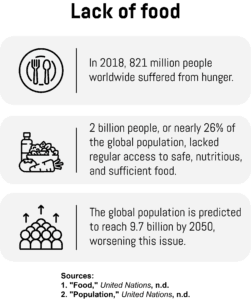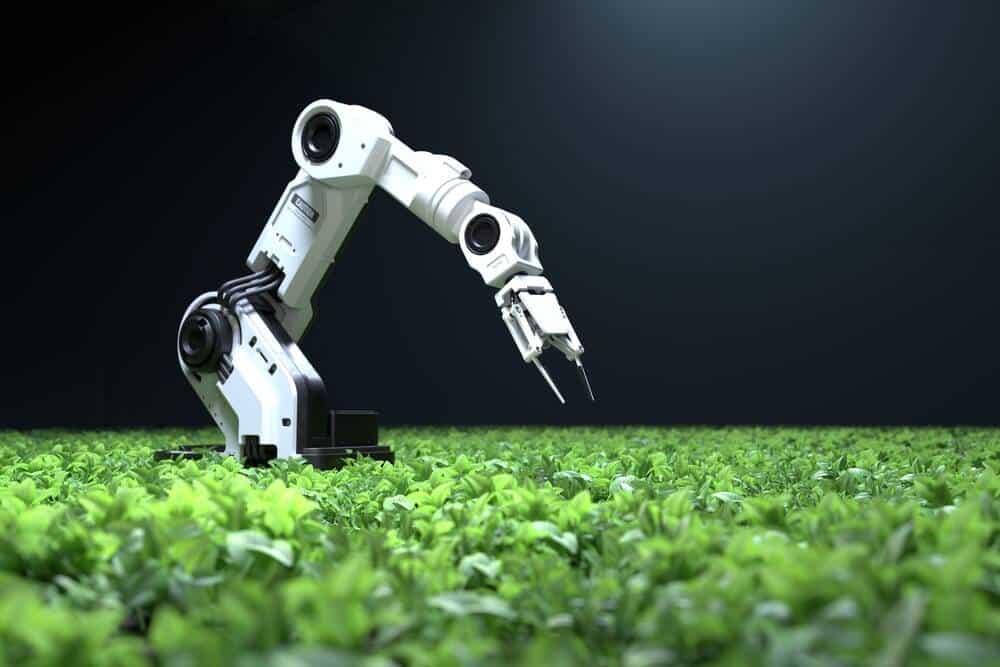- A revolutionary early warning system can predict wheat rust disease
- AI enables farmers to monitor the condition of their crops from anywhere
- XAG unveils a drone-based horticulture crop solution
- Russian farmers outfit cows with VR headsets to boost milk production
- How technology is transforming agriculture
Maintaining a healthy, well-balanced diet is essential for human health and wellbeing. It provides the body with all the nutrients it needs to operate at full capacity throughout the day and keeps chronic illnesses such as diabetes and heart disease at bay. Unfortunately, not everyone can enjoy the benefits of a healthy diet. According to the United Nations (UN), an estimated 821 million people worldwide suffered from hunger in 2018, while more than 2 billion, nearly 26 per cent of the global population, lacked regular access to safe, sufficient, and nutritious food. With the world’s population predicted to reach 9.7 billion by 2050, things are only expected to get worse in the future.

It’s obvious that feeding the world’s growing population is going to be an enormous challenge, one of the biggest our society will have to face in the coming years. The UN has gone so far as to suggest that we might have to double global food production by 2050 to meet the demand. Furthermore, this increase in food production would have to be accompanied by a decrease in the agricultural sector’s environmental impact, currently amounting to approximately 26 per cent of global greenhouse gas emissions. Sadly, our existing agricultural systems don’t seem to be up to the task. There’s still hope, though, but it will require a major transformation of current agricultural systems through the wider adoption of smart farming technologies that will enable farmers to boost food production while at the same time reducing their impact on the environment.
Technologies like artificial intelligence, machine learning, drones, robots, and IoT devices have taken on an increasingly prominent role in the agricultural sector in recent years. These innovations allow farmers to monitor field conditions remotely, assess crop health, automate various tasks, improve productivity, reduce waste, and anticipate and prevent adverse events. And according to a recent report published by MarketsandMarkets, the IoT in agriculture market is predicted to grow from $12.7 billion in 2019 to $20.9 billion by 2024.

A revolutionary early warning system can predict wheat rust disease
Ethiopia is the largest wheat producer in sub-Saharan Africa. However, its wheat production has lately come under serious threat from wheat rust, a type of fungal disease that can be spread over long distances by the wind, quickly turning into an epidemic that can dramatically affect wheat yields. To complicate the matter even further, the pathogens that cause rust diseases are constantly evolving and giving rise to new strains of wheat rust. There may be a solution, though. An international team of scientists recently developed an early warning system that can predict wheat rust diseases up to a week in advance and deliver these predictions directly to farmers’ phones.
Developed in a collaboration of the Ethiopian Institute of Agricultural Research (EIAR), the Ethiopian Agricultural Transformation Agency (ATA), the University of Cambridge, the UK Met Office, and the International Maize and Wheat Improvement Center (CIMMYT), the system combines near real-time information from wheat rust surveys conducted by EIAR, regional research centers, and CIMMYT with crowd-sourced information from the Farmers’ Hotline operated by ATA. The information is then analysed by the University of Cambridge and the UK Met Office to deliver automated weekly forecast models for wheat rust spore dispersal and environmental suitability. The resulting data is fed into an early warning unit that’s updated on a daily basis, which then passes it along to national authorities, development agents, researchers, and farmers. “If there’s a high risk of wheat rust developing, farmers will get a targeted SMS text alert from the Farmers’ Hotline. This gives the farmer about three weeks to take action,” explains Dave Hodson, a principal scientist with CIMMYT and co-author of the research study.
Another mobile-based early warning system comes from India, where the Ministries of Earth Sciences and Agriculture recently launched a new mobile app called Meghdoot, which will provide farmers with forecasts relating to temperature, rainfall, humidity, and wind speed and direction. This information will be updated twice a week and presented in the form of images, maps, and pictures that will enable farmers to see what lies ahead and figure out the best way to take care of their crops and livestock. Developed by experts from the India Meteorological Department, the Indian Institute of Tropical meteorology, and the Indian Council of Agricultural Research, the app will initially be rolled out to 150 districts, before it’s made available to the rest of the country.
AI enables farmers to monitor the condition of their crops from anywhere
EOS Earth Observing System, one of the world’s leading retailers for remote sensing satellite data, recently announced the launch of a new digital agricultural platform called EOS Crop Monitoring, which uses artificial intelligence, satellite imagery, and weather data to provide farmers with comprehensive information on their fields. The platform gathers data from various sources and processes it through AI-driven algorithms to extract valuable insights. Once the data is analysed, the system notifies the user of any potential risks, such as abnormal changes in the values of vegetation indices or intense drops or spikes in temperature, allowing them to respond in a timely manner and save a great deal of time and money. The platform also provides historical weather reports for the past 10 years, 15-day weather forecasts, detailed soil moisture and soil type mapping, recommendations on planting time and crop selection, and crop yield predictions.
According to the company, combining the platform with other precision agriculture solutions will enable farmers to reduce their costs by anywhere between 5 and 20 per cent. “Agriculture has never been easy, but the farming conditions are becoming more and more complicated. The global resources are stretched while the population is growing. This is why implementing technology-based solutions is crucially important,” says Alexander Sakal, the CSO of EOS Crop Monitoring. “We want to help agri entrepreneurs from all around the world to achieve better results by wasting less, getting more, and becoming more sustainable in general. Basically, we suggest a set of tools to benefit everyone — the user, the consumer and the planet.”
Similarly, the Washington-based startup Innov8 Ag Solutions has developed a cloud-based monitoring service that combines weather data from Washington State University’s AgWeatherNet and solar-powered sensors installed in orchards and fields with multispectral satellite data to provide valuable insights to farmers. Farmers can also feed the system readings for irrigation levels, pesticide usage, and even labour and equipment usage by simply taking a photo of a logbook or whiteboard. The system allows farmers to monitor the health of agricultural crops, as well as keep track of parameters such as market prices, seed availability, and crop storage capacity. All of this data, which is updated every 10 minutes, is handled by Azure Farm Beats, Microsoft’s new cloud-based platform for data-driven farming. Innov8 Ag Solutions also provides its users with geo-specific insights on planting, watering, fertilising, spraying, and harvesting their crops every day.
XAG unveils a drone-based horticulture crop solution
XAG, a global leading agriculture technology company and industrial UAS manufacturer, recently joined forces the German pharma and chemicals giant Bayer, to demonstrate the capabilities of its new agricultural unmanned aerial system (UAS). It’s an innovative horticultural crop solution that uses artificial intelligence and 3D flight mode to address issues associated with applying pesticides and fertilisers on complex terrains, such as hills, mountains, and terraces. The demonstration was held at a typical citrus orchard in Jiande Town in the Chinese city of Hangzhou that spreads over 1.5 hectares. Located in rugges hills, the orchard consists of mandarin trees of varying heights planted in uneven density. A team of three workers would typically need about three days to spray the entire orchard manually. The drone, on the other hand, was able to spray half the orchard area in just 10 minutes.
Through a combination of aerial surveying, 3D modelling, AI recognition, and targeted spraying, XAG can ensure that each fruit tree gets its required dosage, without using excessive amounts of water and pesticides or exposing human operators to toxic chemicals. A drone is first sent to fly over the orchard to build an accurate 3D model of the terrain. This data is then fed into XAG Agriculture intelligence (XAI) for AI analysis, which identifies field edges and the location and size of each tree on the 3D map, before sending in another drone to commence the spraying operation. According to the company, the system can identify almost 7 hectares of fruit trees in just one second with 98 per cent accuracy.
Russian farmers outfit cows with VR headsets to boost milk production
In what may be the strangest application of VR technology yet, farmers at a dairy farm near Moscow are conducting an experiment that involves outfitting cows with virtual reality headsets in an attempt to improve their mood and increase milk production. Designed by VR developers in cooperation with veterinarians, the headsets were specifically adapted for the cows to fit the shape of their heads. The developers also had to take cows’ higher perception of the colour red but weaker tones of blue and green into account, designing a unique program that could simulate summer fields in a way that would be visible to a cow.
Farm animals often live in poor conditions that adversely affect their emotional state, and consequently, milk production. By simulating a realistic virtual environment that would make the cows believe they were out in a green field rather than trapped in a barn, the farmers hope they’ll be able to help them relax and improve their mood. Early results seem to be quite promising, with farmers reporting a decrease in anxiety and an increase in the overall mood of the herd. However, further experiments are required to determine whether this change in mood has any impact on milk production.
Augmented and virtual reality technologies could also have other useful applications in the agriculture industry. The Australian national science agency CSIRO recently announced it developed technology that uses AR headsets, sensors, and next-generation data interaction techniques to help prawn farmers keep track of key water quality parameters like dissolved oxygen and pH levels in real time. “This is done using state-of-the-art wearable and hands-free technologies that they use while they’re walking around and managing the ponds,” explains Dr Mingze Xi, a postdoctoral fellow at CSIRO. “This could give them the information they need to better manage animal health and feed inputs, for example, and even share the visuals in real time with managers in the office or external experts for fast input.” While the technology will first be tested in prawn farming, the researchers hope it could be adapted for any type of farming in the future.
How technology is transforming agriculture
Agriculture has always relied on technology to accomplish its goals. However, as the world’s population continues to grow, it’s becoming quite obvious that our existing agricultural systems won’t be able to produce enough food to feed everyone. The only way for us to satisfy the growing demand is to bring about a major transformation of the agricultural sector through widespread adoption of emerging technologies like artificial intelligence, machine learning, drones, robots, and IoT devices. This transformation is already under way, as evidenced by the growing number of innovative tech solutions on farms around the world, helping farmers improve productivity, reduce waste, monitor the health of their crops and cattle, and predict and respond to adverse events in a timely manner.




